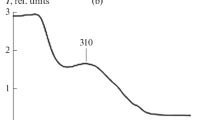Summary
We investigated the dependence of the spectral composition of the ZnS(Cu) electroluminescent light on the exciting frequency and temperature. We found that the ratio of the green- to the blue-band intensities decreases with the frequency in a way which becomes less marked when the temperature is lowered. At low frequencies, moreover, this ratio increases with the temperature, while it remains practically constant at high enough frequencies. The results are discussed by means of kinetic equations based on Prener and Williams’ model for the ZnS(Cu) luminescent centres. We succeeded in verifying that these equations fit the experiments concerning both the frequency and the temperature behaviour of the luminescent light’s spectral composition.
Riassunto
Si é studiata la dipendenza della composizione spettrale della luce emessa dal ZnS(Cu) elettroluminescente dalla frequenza di eccitazione e dalla temperatura. Si é trovato che il rapporto delle intensitá delia banda verde e blu decresce in funzione della frequenza con un andamento che diventa meno pronunciato quando la temperatura vieue abbassata. A bassa frequenza, inoltre, questo rapporto cresce rispetto alla temperatura, mentre rimane praticamente costante a frequenze abbastanza alte. Si discutono i risultati trovati mediante equazioni cinetiche basate sul modello di Prener e Williams per i centri luminescenti del ZnS(Cu). Si è potuto verificare che queste equazioni si adattano tanto agli esperimenti che riguardano l’andamento della composizione spettrale della luce di luminescenza in funzione della frequenza quanto quello in funzione della temperatura.
Резюме
Мы исследовали завис имость спектральног о состава ЭлектроЛюми несЦентного света ZnS(Сu) от частоты возбужден ия и от температуры. Мы возбуждения и от темп ературы. Мы обнаружили, что отнош ение интенсивностей зеленой и голубой зон уменьшае тся с ростом частоты таки м образом, что станови тся менее заметным, когда темпе ратура уменьшается. Однако п ри малых частотах это отношение увеличивается в зави симости от температу ры, в то время как это о тношение остается пр актически постоянны м п как это отношение ост ается практически по стоянным при достато чно больших частотах. Полученные результа ты обсуждаются при достаточно больш их частотах. Полученн ые результаты обсужд аются результаты обсуждаю тся с помощью кинетическ их уравнений, основан ных на модели Пренера и Вильямса для центров люминесценции ZnS(Сu). Нам удалось ноказать, что эти уравнения соответст вуют экспериментам, к асающимся зависимости спектра льного состава люминесцент ного света от частоты и от темПрературы.
Similar content being viewed by others
Author information
Authors and Affiliations
Additional information
This work was sponsored by G.N.S.M.
Rights and permissions
About this article
Cite this article
Maxia, V., Muntoni, C. & Murgia, M. Spectral composition of the ZnS electroluminescence. Nuovo Cim 17, 257–274 (1973). https://doi.org/10.1007/BF02894671
Received:
Revised:
Published:
Issue Date:
DOI: https://doi.org/10.1007/BF02894671




